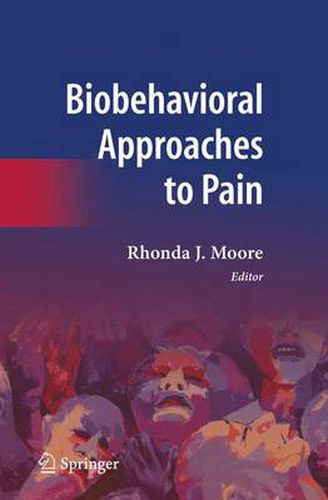Readings Newsletter
Become a Readings Member to make your shopping experience even easier.
Sign in or sign up for free!
You’re not far away from qualifying for FREE standard shipping within Australia
You’ve qualified for FREE standard shipping within Australia
The cart is loading…






This title is printed to order. This book may have been self-published. If so, we cannot guarantee the quality of the content. In the main most books will have gone through the editing process however some may not. We therefore suggest that you be aware of this before ordering this book. If in doubt check either the author or publisher’s details as we are unable to accept any returns unless they are faulty. Please contact us if you have any questions.
Pain is a common symptom, yet it is frequently underevaluated and undertreated. It is difficult to define, describe-and sometimes to prove. It’s pain, and suspicions of exaggerations often add further insult to a patients’ injuries. Biobehavioral Approaches to Pain translates this highly subjective experience-and its physical, psychological, social, and cultural dimensions-into practical insights key to transforming the field of pain management.
This pathbreaking volume synthesizes a rich knowledge base from across disciplines, including neurobiologic, genetic, biobehavioral, clinical, narrative, substance abuse, health services,ethical and policy perspectives, for a deeper understanding of the impact of pain on individual lives and the larger society. Its international panel of contributors highlights special issues and review best practice guidelines, from placebo effects to cancer, Whiplash Associated Disorders to pain imaging to complementary medicine, phantom limb pain to gene therapies to AIDS. Among the topics covered:
The distinction between acute and chronic pain: is it clinically useful?
Improving clinical assessment of patients with pain.
Age and sex differences in pain.
The what, how and why of the placebo and nocebo effect
Psychosocial and partner-assisted biopsychosocial interventions for disease-related pain
Substance abuse issues in pain treatment.
The personal, social and economic costs of chronic pain.
Biobehavioral Approaches to Pain offers clinical and health professionals, psychologists, as well as specialists in pain management or palliative care, new directions in their ongoing dialogue with patients. Given the prevalence of pain in the general population, it should also interest researchers and students in the field of public health.
$9.00 standard shipping within Australia
FREE standard shipping within Australia for orders over $100.00
Express & International shipping calculated at checkout
This title is printed to order. This book may have been self-published. If so, we cannot guarantee the quality of the content. In the main most books will have gone through the editing process however some may not. We therefore suggest that you be aware of this before ordering this book. If in doubt check either the author or publisher’s details as we are unable to accept any returns unless they are faulty. Please contact us if you have any questions.
Pain is a common symptom, yet it is frequently underevaluated and undertreated. It is difficult to define, describe-and sometimes to prove. It’s pain, and suspicions of exaggerations often add further insult to a patients’ injuries. Biobehavioral Approaches to Pain translates this highly subjective experience-and its physical, psychological, social, and cultural dimensions-into practical insights key to transforming the field of pain management.
This pathbreaking volume synthesizes a rich knowledge base from across disciplines, including neurobiologic, genetic, biobehavioral, clinical, narrative, substance abuse, health services,ethical and policy perspectives, for a deeper understanding of the impact of pain on individual lives and the larger society. Its international panel of contributors highlights special issues and review best practice guidelines, from placebo effects to cancer, Whiplash Associated Disorders to pain imaging to complementary medicine, phantom limb pain to gene therapies to AIDS. Among the topics covered:
The distinction between acute and chronic pain: is it clinically useful?
Improving clinical assessment of patients with pain.
Age and sex differences in pain.
The what, how and why of the placebo and nocebo effect
Psychosocial and partner-assisted biopsychosocial interventions for disease-related pain
Substance abuse issues in pain treatment.
The personal, social and economic costs of chronic pain.
Biobehavioral Approaches to Pain offers clinical and health professionals, psychologists, as well as specialists in pain management or palliative care, new directions in their ongoing dialogue with patients. Given the prevalence of pain in the general population, it should also interest researchers and students in the field of public health.